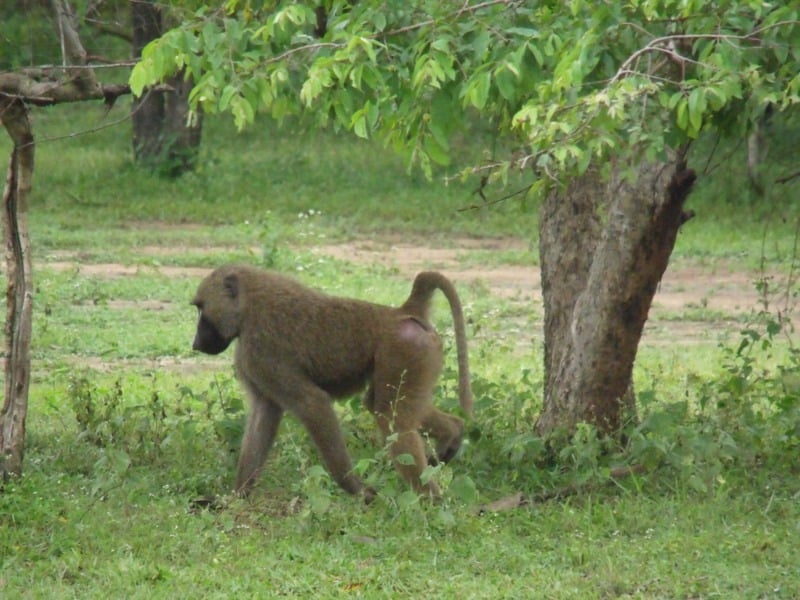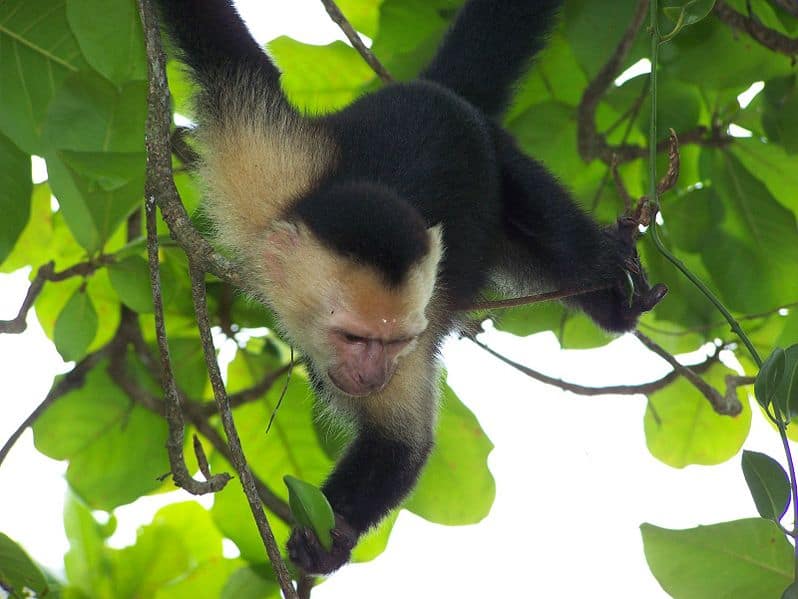Monkey locations tend towards tropical and sub-tropical regions where they can swing across the branches of trees in forests, and although many species prefer to live in the wild, others don’t. These other monkeys live in dry-arid regions or mountainous areas. Additionally, not all monkeys can swiftly swing through the tree tops but live on the ground. Monkeys are only native to Africa, Asia, and Latin America but now live on almost every continent. Let’s find out more about monkey locations and other features. Where do monkeys live?

Monkey locations include forests in tropical and subtropical areas as well as drier, more arid regions.
©Florence Bond – Copyright A-Z Animals
Monkey Habitats
Monkeys live on many continents, but tropical regions are a favorite. For example, primates belonging to the parvorder Catarrhini live mainly in Africa and Asia. Monkeys in this category typically have narrow noses or nostrils that are close together. In contrast, primates that are part of the parvorder Platyrrhini live mainly in Central and South America. Primates in this class are known as new world monkeys, are arboreal, and have relatively small bodies. They range from pygmy marmosets, weighing a mere 3.5 ounces (100g), to spider monkeys, weighing up to 220 pounds (10kg).
Although most monkeys inhabit forests in tropical areas, some species prefer drier, more arid regions. Examples of these are baboons living in southern countries’ dry areas. On the other hand, some monkeys, like the Japanese macaque, live in northern Japan, where there is snow for most of the year. These monkeys spend much of their time bathing in natural hot springs.
Monkeys in Africa
Some common monkey species native to Africa are baboons, colobus monkeys, drills, geladas, guenons, mandrills, one macaque species, mangabeys, and patas monkeys. Most African monkey locations include the tropical and equatorial zones of Africa. In contrast, some live in the semi-arid and rocky parts of northern Africa and parts of southern Africa. Also, many of these primates live in or near areas that humans populate, such as cities, towns, and villages. These monkeys either choose to dwell in trees, along river and mangrove banks or on the ground. And many African monkeys are active during the day, unlike the nocturnal species, which are wide awake at night.
African monkeys also have opposable thumbs, tails that cannot grip onto branches, nostrils that are close together and point downward, and 32 teeth. In addition, many African monkeys have cheek pouches to store food for later consumption. Another interesting fact is that they have thick pads on their buttocks that provide additional support when sitting. African monkeys are known as old-world monkeys. They are closely related to apes, which means they are also closely associated with humans.
Monkeys Locations in Asia

Japanese Macaques live in a monkey location in the snowy mountains of Japan or zoos, like this one.
©Ltshears – Public Domain
Some common monkey species native to Asia are leaf, macaques, proboscis, and snub-nosed monkeys. Most primates on this continent live in southern Asia, with some species indigenous to China and Japan. Asian monkeys occupy tropical forests, snowy mountains, and nearby human settlements. Asian monkeys dwell in trees, along river and mangrove banks, or on the ground like African monkeys. Most Asian monkeys are active during the day, except for a few nocturnal species.
Also, like the African monkeys, those in Asia have opposable thumbs. These monkeys cannot use their tails to grip branches, their nostrils point downwards and are in close proximity, and they have 32 teeth. Many also have cheek pouches where they store food to eat later and thick pads for comfortable sitting. And like African monkeys, Asian monkeys are also Old World primates.
Monkey Locations – Latin America
Some common monkey species in Latin America are capuchins, howlers, marmosets, night monkeys, sakis, spider monkeys, squirrel monkeys, tamarins, titis, uakaris, and woolly monkeys. Most Latin American monkeys occupy parts of southern Mexico through central South America. They live in tropical areas, primarily rainforests in the equatorial zone. Some live in cloud forests, while others live near human settlements. Similar to African and Asian monkeys, Latin American primates inhabit trees and live along river and mangrove banks or on the ground. Most Latin American monkeys are active during the day, except for a few nocturnal species.
Latin American primates are new world monkeys. They have tails that are prehensile or partially prehensile, meaning they can grip onto things. Latin American monkeys have slender bodies and limbs, narrow hands, and typically have non-opposable thumbs. Their noses are flatter than their old-world cousins and point outward. They commonly have 36 teeth and do not have cheek pouches or buttocks pads.

A capuchin monkey location in the rainforests of Latin America.
©Michelle Reback / Creative Commons – Original
Did New World Monkey Ancestors Raft Over From Africa?
A study found that the ancestors of capuchin and woolly monkeys arrived in Latin America by floating across the Atlantic Ocean on floating vegetation and earth over 30 million years ago. Fossils found in Peru by Erik Seiffert, a paleontologist from the University of Southern California, are traced back to a primate group thought to have lived only in Africa. Experts uncovered a set of molar teeth almost identical to the parapithecid Qatrania, a native to the Fayum area of Egypt. Paleontologists found these fossils far inland, meaning the primates arrived on the continent and thrived on the mainland alongside New World monkeys.
Over 30 million years ago, Latin America and Africa were much closer than today. Still, the journey over the Atlantic Ocean could not have been easy. And if there wasn’t much of a divide between the continents at the time, the trip was probably still significant. However, monkeys crossing oceans to different continents and islands is not uncommon as they have made these trips previously and still do. For example, tenrecs and lemurs in Madagascar were not always native to Madagascar. They traveled across the ocean on natural rafts for over 260 miles. Scientists have documented this behavior in small lizards that go island-hopping in the Bahamas on natural rafts.
The photo featured at the top of this post is © iStock.com/olm26250
Thank you for reading! Have some feedback for us? Contact the AZ Animals editorial team.







